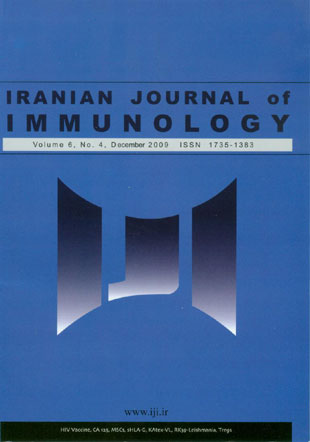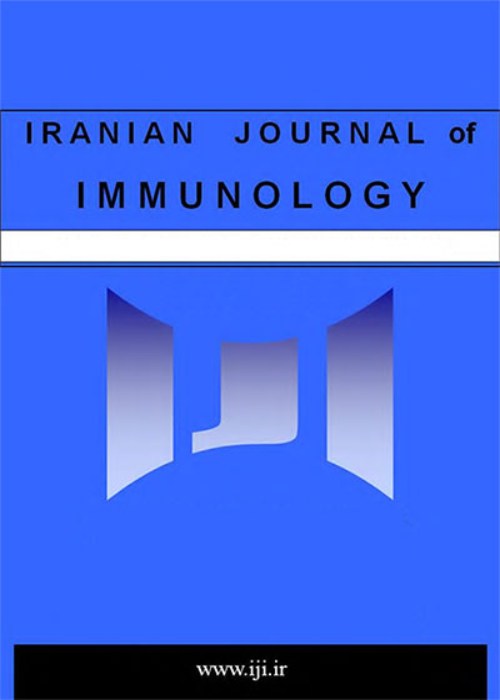فهرست مطالب

Iranian journal of immunology
Volume:6 Issue: 4, Autumn 2009
- تاریخ انتشار: 1388/09/11
- تعداد عناوین: 7
-
-
Pages 163-173BackgroundCell mediated immunity, especially cytotoxic T cell responses against HIV-1 infection, plays a critical role in controlling viral replication and disease progres-sion. DNA vaccine is a novel technology which is known to stimulate strong cellular immune responses. Many DNA vaccines have been tested for HIV infection but there is still no effective vaccine against this infection. Construction of a vaccine consisting of multiple conserved and immunogenic epitopes may increase vaccine efficacy.ObjectiveIn the present study a DNA vaccine candidate constructed from HIV-1 P24-Nef was evaluated and cellular immune responses were assessed in murine BALB/c model.MethodsHIV-1 P24-Nef gene was cloned in PCDNA3.1 expression vector. Mice were immunized with DNA construct and IL-4 and IFN-γ evaluation was per-formed using ELISPOT. Cytotoxicity response was evaluated with Granzyme B ELIS-POT assay and lymphocyte proliferation was evaluated with LTT assay.ResultsAnalysis of immune responses showed that, compared to control groups, the candidate vaccine induced production of higher levels of both IL-4 and IFN-γ (p<0.05). Cytotox-icity and lymphocyte proliferation responses of mice vaccinated with the candidate vac-cine were significantly increased compared to control groups (p<0.05).ConclusionHIV-1 P24-Nef DNA construct displayed strong immunogenicity in a murine model
-
Mesenchymal Stem Cells Do Not Suppress Lymphoblastic Leukemic Cell Line ProliferationPages 186-194BackgroundSeveral studies have demonstrated the immunosuppresive effects of mes-enchymal stem cells (MSCs) in allogeneic or mitogenic interactions. Cell-cell contact inhibition and secretion of suppressive soluble factors have been suggested in this re-gard.ObjectiveTo investigate if adipose derived MSCs could inhibit Jurkat lym-phoblastic leukemia T cell proliferation during coculture.MethodsAdherent cells with the ability of cellular growth were isolated from normal adipose tissues. Initial charac-terization of growing cells by flow cytometry suggested their mesenchymal stem cell characteristics. Cells were maintained in culture and used during third to fifth culture passages. Jurkat or allogeneic peripheral blood mononuclear cells (PBMCs) were la-beled with carboxy fluorescein diacetate succinimidyl ester and cocultured with increas-ing doses of MSCs or MSC culture supernatant. Proliferation of PBMCs or Jurkat cells under these conditions was assessed by flow cytometry after 2 and 3 days of coculture, respectively.ResultsResults showed the expression of CD105, CD166 and CD44, and the absence of CD45, CD34 and CD14 on the surface of MSC like cells. Moreover, ini-tial differentiation studies showed the potential of cell differentiation into hepatocytes. Comparison of Jurkat cell proliferation in the presence and absence of MSCs showed no significant difference, with 70% of cells displaying signs of at least one cell division. Similarly, the highest concentration of MSC culture supernatant (50% vol/vol) had no significant effect on Jurkat cell proliferation (p>0.6). The same MSC lots significantly suppressed the allogeneic PHA activated PBMCs under similar culture conditions.ConclusionUsing Jurkat cells as a model of leukemia T cells, our results indicated an uncertainty about the suppressive effect of MSCs and their inhibitory metabolites on tumor or leukemia cell proliferation. Additional systematic studies with MSCs of differ-ent sources are needed to fully characterize the immunological properties of MSCs be-fore planning clinical applications.
-
Pages 195-201BackgroundPregnancy is a successful transplantation. The factors evading rejection of the fetus are poorly understood. Recently an interest has grown, in HLA-G molecules as one of these factors. Since these antigens are mainly expressed on the surface of cytotro-phoblasts that are in direct contact with maternal tissues, it has been suggested that these molecules may have a role in induction of immune tolerance in mothers.Objectiveto find the association of soluble HLA-G (sHLA-G) and the success of pregnancy with intracyto-plasmic sperm injection (ICSI) procedure.MethodsIn this study, the supernatant of 287 individually cultured embryos corresponding to 96 women under ICSI procedure were as-sayed for soluble HLA-G1 and G5 by a sandwich ELISA.ResultsClinical pregnancy suc-cessfully occurred in 30 of candidates. No differences in clinical parameters (age, infertility duration, stimulation regimen) were observed between pregnant and nonpregnant women under ICSI procedure. None of the embryo supernatants in either group showed any detect-able sHLA-G molecules.ConclusionOur results showed that detectable level of sHLA-G is not produced by day 2 embryos and such a measurement may not provide reliable infor-mation for embryo selection and estimation of pregnancy success.
-
Pages 202-207BackgroundVisceral leishmaniasis (VL) is an endemic disease in some parts of Iran. Many techniques have been used for diagnosis of VL, among which the urine based la-tex agglutination test (KAtex) is a promising one.ObjectiveTo compare three diag-nostic tests of VL including KAtex, ELISA and Direct Agglutination Test (DAT) in VL patients and healthy controls in the south west of Iran.MethodsSerum (n = 29) and urine samples (n = 31) were collected from parasitologically confirmed VL patients. Control samples were obtained from healthy individuals (n = 61) and also from patients with infectious diseases other than VL. The collected serum samples were tested by DAT and ELISA using crude antigen from promastigotes of Leishmania infantum and the urine samples were tested by KAtex.ResultsSensitivity and specificity of KAtex for diagnosis of VL was found to be 83.9% and 100%, respectively. Sensitivities of DAT and ELISA were 93.1% and 86.2% and their specificities were 100% and 90.5%, respectively.ConclusionKAtex yielded a satisfactory sensitivity and specificity in di-agnosis of VL in Iran and can be recommended as a rapid, field applicable and reliable test for diagnosis of VL in this region.
-
Pages 208-215BackgroundUntil now, the comparison of the rK39 strip test (RKT) and direct agglu-tination test (DAT) for detection of visceral leishmaniasis (VL) is exclusively based on either positive or negative qualification of the reaction outcome.ObjectiveIn this study, we compared the diagnostic performance of RKT and DAT for VL both qualita-tively and semi-quantitatively.MethodsFor comparison based on semi-quantitative grounds, the execution of RKT and DAT was according to the standard procedures. For comparison on semi-qualitative grounds with DAT, the RKT was applied to aliquots from positive samples that were two-fold serially diluted in saline to determine, as for the DAT, the end-point reaction in RKT.ResultsWhile qualitatively both RKT and DAT demonstrated comparable reliability for VL detection (sensitivity = 96% and specificity = 98.7% or 99.3%), no significant correlation (r = 0.13) could be established between intensities of their positive reactions in 25 cases studied. A negative correlation was further determined in those 25 VL cases between the positive intensities of the RKT and antibody levels measured semi-quantitatively with the same procedure (r = -0.36) or the DAT (r = -0.30). Irrespective of the low, moderate or high antibody levels measured with RKT (<1:8 and 1:16-1:32 >1:256) or DAT (< 1:25,600 and 1:51,200- 1:409,600 > 1:3,276,800) in patients with confirmed or unconfirmed VL infection, exclusively strong positive intensities were obtained with RKT.ConclusionFor further optimizing diagnosis and simultaneously assessing magnitude of immune response to L. donovani infection in Sudanese patients, the combined application of RKT and DAT is recom-mended.
-
Tehranolide Could Shift the Immune Response towards Th1 and Modulate the Intra Tumor Infiltrated T Regulatory CellsPages 216-224Artemisia diffusa contains a new type of sesquiterpene lactone with an endoperoxide group (Tehranolide).ObjectiveDue to the existing similarity between the structures of Tehranolide and Artemisinin, it was hypothesized that Tehranolide would have similar effects as Artemisinin. In this study, the immunotherapeutic effectiveness of Tehrano-lide was investigated by direct intra-tumoral injection.MethodsTehranolide was puri-fied from Artemisia diffusa, and its effect on the tumor volume was investigated. The splenocyte proliferation, shifting of cytokine profile, and the presence of naturally-occurring CD4+CD25+Foxp3+ Treg cells were assessed to describe the anti-tumor im-mune response.ResultsAnalysis of immune response showed that, intra-tumoral injec-tion of Tehranolide decreased the rate of tumor growth compared to control group. Fur-thermore, the proliferative response of mice treated with Tehranolide was enhanced. In comparison with the control group, production of both IL-4 and IFN-γ was induced (p<0.05). The results indicated a decrease in tumor CD4+CD25+Foxp3+ T lymphocytes in the Tehranolide-treated group compared to the control group.ConclusionTreatment of tumors with Tehranolide attenuated CD4+CD25+Foxp3+ Treg cell-mediated immune suppression and elicited a persistent anti-tumor immunity against cancer.


